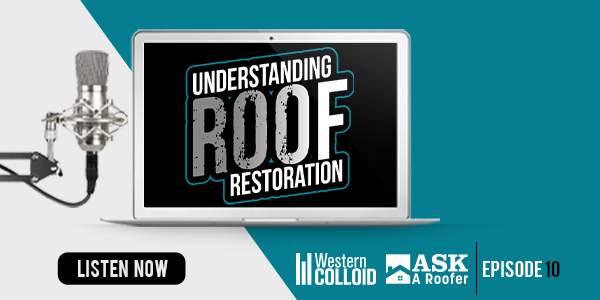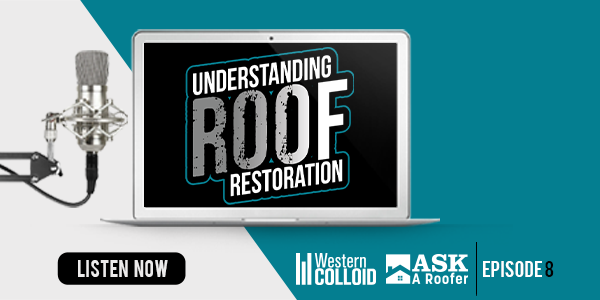Understanding Roof Restoration Episode 10 - Restoring Spray Polyurethane Foam Roofing - PODCAST TRANSCRIPTION
October 11, 2023 at 2:00 p.m.Editor's note: The following is the transcript of a live interview with Greg Hlavaty and Hal Leland from Western Colloid. You can read the interview below or listen to the podcast.
Karen Edwards: Hello and welcome to the Understanding Roof Restoration Podcast. I'm your host, Karen Edwards from AskARoofer.com. The Understanding Roof Restoration Podcast dives deep into the topic of restoring roofs. As the popularity of roof restoration continues to grow among building owners and contractors, there are many questions that arise.
With a wide variety of roofing systems on existing buildings and many available restoration options, we turn to the experts at Western Colloid to answer your questions on roof restoration. Greg Hlavaty, Hal Leland, and the team at Western Colloid have been manufacturing and installing these systems for more than 50 years, and they have seen it all. We will tackle a different topic each month and answer questions submitted by you, our listeners.
Hi, and welcome to this episode of Understanding Roof Restoration. I'm Karen Edwards with Ask A Roofer, and I love to welcome back Hal Leland and Greg Hlavaty from Western Colloid. Welcome.
Hal Leland: Hello.
Greg Hlavaty: Good to be back.
Karen Edwards: Good to see you guys. We've got an exciting episode today because we're going to talk about restoring spray polyurethane foam roofing. But I thought before we get into talking about restoring it, maybe you could provide a little education on what spray polyurethane foam roofing is for those listening who might not know.
Greg Hlavaty: Sure. We can do that. I'll start off a little bit because I have the oldest history here. Spray polyurethane foam has been around almost as long as I have in the past, maybe not quite, but close. It's chemistry through combination of several... First, I'm going to say, I'm not a urethane foam expert in that industry. I've been associated with it for many years, but I'm not directly involved in it and the specific chemistries that are used here and there and what have you.
But early on it was a mixture of chemicals that were sprayed in a special gun that mixed these chemicals together at the head of the gun, the spray tip. Once they were combined, they foamed up. It's a takeoff from the foam that was used and they made ice chests and other things where they filled it with a foam. Foam did a great job of having insulation, a good insulation value, so they started spraying it on many things, cold rooms, tanks, all kinds of things where they needed to control the temperature inside.
It was adapted to roofs. However, in roofs, they found out that foam by itself breaks down quite dramatically when it is exposed to UV, the sun, and weather. In order to use it on a roof, they had to come up with a surface of that foam so they could use the insulation and then they would put a protective surface on it. Early on they used some of the same stuff they used today. They used acrylic roof coatings, usually embedded with granules, No. 11 Roofing Granules just like they used on cap sheet.
They used urethane coating, the rubberized urethane coating. The film urethane, not the spray foam. That was a very good protective surface, and they also used silicone. It was when some of the first silicone roofs were done back in the '70s and '80s, they put silicone as the high-end foam. You put a silicone coating on top of your foam. Silicone weathered well and the foam had strength. It was a great, and it still is a great system in itself. It gives you insulation and a weather barrier.
All those things lent themselves to putting it on roofs. It worked better on some than others. Plywood deck roofs were harder to put it on because the plywood flexed and moved. Since then, they use it mostly for at least in the Western US where we're at as reroofs. They go over old existing roofs and what have you. They'll put it on metal roofs. Some of these things can be problematic. The benefits of the foam roof is that you get insulation and a good weather barrier and a fairly strong roof.
They've improved the foam over the years, the chemistry of it to make it stronger and denser. Early on, the foam would break down, the cells would open up. And instead of holding out water, it would actually suck in water into the roof. That's why they needed that protective surfacing on it. As long as you have a foam roof and you keep that protective surfacing on, you've got a pretty good system. What we found over the years is is that once that protective surface breaks down, you can have a real nightmare because it can be not the easiest roof system there is to make repairs.
Maintenance, maintenance, maintenance is the word for foam roofs. There are some people that every so many years, whether it's seven years or eight years or nine years, they recoat their foam roof and they can make them last a long time. But very few people keep to that, so they end up with foam roofs that are degrading. Once it becomes exposed to the UV, it becomes fryable and it breaks down the fire ratings. Hal knows a little bit more about that. That has always been issues with foam roofs because foam early on didn't have a fire rating.
They relied on the surfacing. Right, Hal? I mean, that's probably where they used the granules. They put heavy granules on it and coating. Some of it was for bird proofing. But anyway, that brings us to where we are today. There's still a lot of foam foam roofs out there, and it's the ones that haven't been treated well, and they are some of the most problematic roofs we run across. Some are not saveable. Some cannot be saved. They've deteriorated to such an extent you can't save them. The foam has broken down. It has soaked up, have become a sponge.
Karen Edwards: That's a good segue into the next question. Some of them are saveable. How do you know? What kind of things are you looking for? If you're called out to look at a roof as a contractor, how would we know if this roof is a candidate for restoration?
Hal Leland: It's very hard to actually know. I mean, this is probably the hardest roof to read. You can go up on a built up roof and you're going to look around the drains and waterways and you're going to see the deterioration and what's happening. But these foam roofs, like Greg said, they were their Cadillac back in the day. If you had a urethane on top of it, it was amazing. Silicone worked very, very well, but it was supposed to be a closed cell polyurethane foam, and it turned out not to be.
These things can hold water forever. We look at these things and we have contractors going over them. We do them every year. Sometimes we won't know that a contractor's doing it, and you'll come back and say, "This thing's blistering up," because we put a fully reinforced membrane over the top of these foam roofs, a waterproof membrane. There's no place for that water to go. A lot of these roofs, like Greg said, are metal decks, so the water can't go down. It's got to come up.
When these things heat up, these things start to blister all over the place. It's aesthetics mostly, but they are holding water. You can't normally tell where that water's being held, and they can hold water for a decade. The blisters, everyone wants to cut them out. Sometimes if the weather's good, you can cut them out in the summer and try and let that roof bake out a bit and then cover it back up, put a membrane over the top of it for the fall season.
We're not super concerned about a roof holding a ton of water, a built up roof, but a foam roof, we're always concerned about it. It's the only roof we really want to know what's happening as far as moisture content.
Karen Edwards: Is it possible to make repairs for the roofing system prior to restoring it? Like you said, sometimes in the summer, maybe you could cut that out and get through. But what are some best practices in prepping that roof for a restoration?
Greg Hlavaty: Well, they'll do moisture scans, right, Hal?
Hal Leland: That's exactly what I was going to say. That's where we'd like to see one.
Greg Hlavaty: They can do moisture scans, and then what happens is is they might cut out just sections. We know we've got moisture here, they'll cut it out, and they'll re foam maybe that three foot by three foot or six foot by six foot area with foam trying to bring it back to the same level as the existing foam. And then we can apply one of our reinforced coating systems, our fluid-applied reinforced roofing. That's the good news about foam roofs. The good news about foam roofs is is they've already invested money in some insulation on that roof.
So often when it's bad with blister, with some moisture, holding moisture, or they see a little foam exposed, a small amount of foam exposed can be remediated. They can brush away the dusty foam, what we call fried foam. They'll brush it away with a broom, and then they will put one of our systems over. The good thing is is now they've got that insulation that they don't have to throw away. They don't have to haul that to the dump, which is expensive too, because many foam roofs adhered directly to the deck and they're not easy to get off.
It's expensive to remove one. But then when we put a membrane over it, now they've got a new membrane on top of it. They let the foam does what it does well, which is insulate, and they've got a membrane that will not crack and split like the old original. Because on foam roofs, they just put a coating on. They didn't put a reinforced system on most of them. We do have a lot of roofs in Arizona, they used cementitious coating on, which is where they put a coating down of different types.
Sometimes it was asphalt emulsion. Sometimes it was a urethane type coating, asphalt modified urethane, different thing. And then they broadcast either small rock into it or granules, and then they took a white cementitious coating, which is a mixture of white cement, lime, maybe sometimes pro light, but a vinyl additive. If it's done well, it had a good acrylic or vinyl additive, and that put a real good UV barrier on top of that. But that crumbles over time. It is not elastomeric.
It is a hard brittle. It did a good job on the initial foam roof, and those rifts have lasted a long time, but now they are breaking down. We do a lot of remediation of those where they have to prime that crumbling cementitious coating with one of our primers, or we make a primer from our asphalt emulsion to bond that down, and then we put our membrane over. But again, the good news is is now we've got a membrane on there that they can maintain for decades, and they've got a foam that they've invested in years before that they don't have to throw away.
Because the other option is if you talk to a foam contractor and if there's some of the people that do foam also, they're sitting there raising their hand saying, "Wait a minute, Greg. We remediate foam risk," and they do it usually by scarifying the foam, and scarifying means they have a machine, looks a little bit like a lawnmower.
Hal Leland: Like a lawnmower, yep.
Greg Hlavaty: It's got blades on it that grind down into the foam, and they grind it down until they get to a good layer of foam. And then while that is very fresh, they put another layer of foam over it and then recoat that. That's an option. It's not one of our options. We're not in the foam business. We are a member of the SPFA, Spray Foam Manufacturers Association, and have been for decades. We like being a member.
We like the association. It's a great group of people, but we're there because we're a repair product for people that have foam roofs and. One of the avenues that you can take to repair a foam roof, like I said, the other way is to use a foam contractor that will scarify it and then put another layer over it, if it isn't too far gone.
Hal Leland: That can be problematic too because it's hard to get adhesion on a 20-year-old foam roof, even if he's scarified it. He exposed this fresh closed cell polyurethane. This is a real art for them, putting on a foam roof. I mean, we've got them all over Northern California, Southern California, into the desert. There's probably a dozen applicators over the last 20 years that did a good job at it. Most of them are horrible.
Karen Edwards: Oh no.
Greg Hlavaty: It looks like the surface of the moon. They are cratered. They are highs and lows. If a good foam contractor, when he goes out to a job, he has a little weather station built onto his equipment. He knows the humidity. He knows the air movement, the wind speed, everything that goes on, and he records that for future reference if there's issues that come up. All that matters. But most of the phone contractors have a pump, one of the expensive spray guns, or maybe not even one of the expensive ones, and barrels of part A and part B.
Hal Leland: Part A and Part B.
Greg Hlavaty: They get out there and they spray it on like they're spraying coating on. Hal's exactly right. A good foam applicator can put it on and it's beautiful. It lays out beautifully. As a matter of fact, I have many pictures that I have to call up and I'll look at and I'll say, what kind of a roof is this? It's really smooth, but I was told it's a foam roof. No, that's a foam roof. It was just done well, really well. But there's other roofs you have no question about it, it's a foam roof, and it was done by somebody that was not the best.
Hal Leland: They were hung over or didn't care.
Greg Hlavaty: It was a Monday morning and he should have stayed home that day.
Karen Edwards: We're going to talk in just a minute. I'm going to take a quick break here because we're going to hear a message from our sponsor. When we come back, we're going to keep talking about some of the remediation and things that need to happen before you can restore that roof. Stay tuned. We'll be right back.
Audio: This podcast is brought to you by Ask A Roofer and Western Colloid Fluid Applied Roofing. When you're looking for answers for your roof, what better place than AskARoofer.com. If you are looking for answers on restoring your commercial industrial or low slope roof, look no further than Western Colloid. For over 50 years, they have been bringing old roofs new life. Together, we're helping contractors, building owners, property managers, architects, engineers, and consultants choose the best commercial roofing system. Find Western Colloid today on AskARoofer.com.
Karen Edwards: Okay, we're back. We are talking about restoring spray polyurethane foam roofs, and we've learned so far that they're quite popular. When they're done right, they're great. But more often than not, many of these roofs were not installed ideally. And in those situations, there does need to be some remediation.
We talked about scarifying, which is kind of getting down on the roof and cutting until you get to a good level. But I'm curious, what other things do we need to be looking for with these roofs? You talked about the foam holding water and collecting water. Are there other issues that we need to be aware of?
Hal Leland: They're the same issues, right, Greg? You're really paying attention to drains and the details, just like any other roof. But these foam roofs can hide a bunch of secrets unlike a built up roof.
Greg Hlavaty: So many of the foam roofs, especially the ones that were not originally done as foam, and there's not that many of them around where the first roof is a foam roof. It's always the second roof. What they've done is they've sprayed around. The proper way is like with any other insulation, like with the new insulation laws that are out there now, regulations, is that you raise the curbs, you raise the pipes, you raise the roof jacks. I can't tell you how many times we get up on a roof and the T top of a roof jack is about half an inch above the surface of the foam.
If you get enough rain, it's going to drain into that. All those things need to be cut out and replaced, and they don't always have to be replaced with foam. The nice thing is now there's lots of foam kits that you can use. Everything from a whipping cream can of foam that you just turn upside down and the nozzle... Filling cracks and those kinds of things, and voids. Up to little small spray kits where you can spray a larger area where there's two bottles that connect together with a hose and it comes with the kit and you can fill it.
But there's other ways also. What we've done over the years is if you've got blisters that you cut out, which a blister and foam is usually the foam and the coating itself might be two inches thick or an inch and a half thick, you cut that out. Now you've got a void. You want to fill those voids, and you can fill it with foam if you're good at it. Even if you're not, you're going to fill it with foam and then you're going to shave the top off because it's not going to be smooth, or you can fill it with mortar.
A lot of people will use a lightweight mortar mix with cement and lighters, even just the same kind of patch that they use. Guys that do tile work, when they do the eaves and ridges with tile, they have a mortar they mix up and put the tile. That's a little heavier, but it cures out fast and it sets up. You can fix those voids and the low spots that you've cut out with foam or a mortar, a lightweight mortar, and then you can go over it with a system. Our Acrylic Mastic is used heavily by people that do repairs to foams.
It's a water base. It is very elastomeric. You can cracks and splits in small depressions, if they're not more than a quarter of an inch thick that you're going to put on, and polyester fabric. You can fix a lot of things on a foam. You want to go up and really walk a foam roof like you do a BUR and fix all these spots first. If you're cutting out T tops and other types of flashings that you got to raise because the foam is too high, and sometimes the problem is its skylights. The foam where skylight works, it's got a nice curb there and the water runs around it when it runs down a roof.
With foam, sometimes they filled it within a half an inch of the top, the edge of the skylight. When it rains, it's going to run up and into it. Those things have to be addressed. There's another positive to foam roofs and that is drainage. They've put foam around drains and around crickets, down crickets. They'll come right to a drain or a scupper, and it'll just die off into the drain.
Well, now we know if they're holding water on that, you can take that foam that might be, if it's properly done, at least an inch and a half thick and shave that back two, three feet out onto the roof and actually make a nice drain sum, where you can create positive drainage on a roof because you've got a lot to work with that foam. And then we'll put our system over it. Go ahead, Hal.
Hal Leland: I just wanted to make a point. When Greg's talking about cutting up around these T tops and pipe flashings, those are things that let the building breathe through the roof. We're normally on a built up roof or a TPO roof or a PVC roof and the membrane, it's that thin, but a foam roof, you're filling a hole that's that big. I just want to make sure that everyone understood that.
Greg Hlavaty: For those of you that are only here in the recorded, he's holding two inches thickness from a quarter inch thick or an eight inch thick.
Karen Edwards: Quite different.
Hal Leland: We're filling these huge voids, that's why these foam packs are convenient or even filled with board stock insulation. If you can fill the void tightly like that, then you put a membrane over the top of it.
Greg Hlavaty: Right. Flash it in.
Hal Leland: It's a lot of detail work there.
Greg Hlavaty: Yep.
Karen Edwards: Are there times when on a foam roof that you can get away with just making some repairs and maybe get a few more years out of it, or is it better to, hey, we're going to make these repairs, let's put a new system on top of it? What's the best thing to do there?
Greg Hlavaty: That's an answer that has a whole bunch of ifs in it. Part of it is how much the building owner can budget. Part of it is how long do they care about this? That's another problem. If you have a building owner that's only going to have this building for two or three more years, then he kind of doesn't care, or maybe he doesn't have the money. Depending on how far gone that foam roof is. In Arizona, this is pretty regular, they go up and do repairs and just put another layer of coating on it, not reinforced or anything else.
And if it's done early enough and often enough, that can give you a lot of years of a foam roof. But we're probably talking about roofs that have already gone beyond that. If you're going to spend two-thirds of the money doing the repairs and using half the amount of coating just putting the coating on it, you might spend that other third of the dollars. Part of it is dollars, years, the knowledge of the contractor, and the life expectancy that a building owner expects to get out of that roof, but sometimes it is a waste of money.
If you were going to spend $20 on a system that's going to give you a complete membrane and $14 on a roof, that's just going to repair it, sometimes it's best to spend that extra six bucks and get the whole package. You're talking about 10 to 20 years against three or four years of extending the life. We can't answer that equivocal, but it depends on all those factors. Once you've got that and you want to save it, save it with something that's going to last.
Karen Edwards: Are there typically incentives for a building owner, not that we're accountants, not that we're giving advice, but for putting that new maybe slightly more energy efficient roof, reflective system? Are there ways that they can save money in the long run with that?
Greg Hlavaty: Well, foam roofs started out that way when there was insulation and you got credits for different... Sometimes it was cities. Sometimes it was agencies. Nowadays, you've already got that foam roof on. I think next month we're going to be talking about cool roofs and how they work. Part of the way insulation works is how big of a battle does it have? Because insulation works through R value, resistance to passing heat through to the membrane. If it's got a lot of heat that it's fighting, there's going to be more heat that comes through that roof.
The way insulation works, you can dramatically increase the insulation value or the value of that. Actually, it's the value of the insulation you put up there really. I'm going to get more value out of it by putting a cool roof over the top, because then it doesn't have to work as hard. You definitely want to put some sort of a cool roof over a foam roof. You want to let that foam have to fight as little heat as possible and it gives you more value. It really does its job better.
You could go up there and waterproof it with a black roof or a dark-colored roof, but then you're diminishing the value of that foam because it's trying to keep out 180 degrees instead of 105 pass through. It only makes sense to use a cool roof.
Hal Leland: Always, always use a cool roof on a foam roof. I mean, we use a cool roof on every roof, but foam is hand in hand. It's part of the...
Greg Hlavaty: Anecdotally, I'll tell you another little thing that we did for years on some foam, not on all foam roofs, but on certain foam roofs and they didn't know how much moisture was in it. They used to put a very light layer of our asphalt emulsion, very thin layer just to turn it black or mostly black. The first hot day, you could walk up on that roof and find every blister on it, because you got it hot. You turned the water underneath into vapor, and then they knew exactly where to go to cut out the blisters.
I'm not sure it's cheap and dirty. It's for sure dirty, but it's a trick to using a moisture scan. It finds every one of those blisters. You go out, you cut them out. You fill it with a dry foam or board stock or something else, and then now you've already primed the roof, and so you then put your system over it. But we had several contractors that use that as a tool to find problems. But it tells you what happens when you get a dark roof on foam and there's a little bit of moisture in it, now you're blowing up water vapor everywhere. You want to keep it cool. You want to let it do its thing.
Karen Edwards: Excellent. Yeah, that's kind of smart. There's technologies now that will help you identify those areas, but there's that I won't want to say old school method, but tried and true. And then you've already got the priming out of the way if that acts as your primer. I like that. Well, this is a good segue because we're going to be talking, as you mentioned earlier, Greg, in next month's episode about cool roofs, about upgrading for energy efficiency, and why it can make such a big difference in a building.
Remember that we want to answer your questions too. You can submit questions to us on AskARoofer.com. You can go to westerncolloid.com. And if we use your questions, we will send you a gift. Everybody likes to get gifts, so be sure to think about what you want to know, send your questions in, and we will answer them. Please be sure to listen to this episode and previous episodes on your favorite platform, Spotify, Apple Podcasts. Wherever you listen to podcasts, you'll find us there.
You'll also find us on AskARoofer.com and on westerncolloid.com. Thank you, Greg. Thank you, Hal. It's been great talking to you about spray polyurethane roofs, and we'll be back next month talking about cool roofs.














Comments
Leave a Reply
Have an account? Login to leave a comment!
Sign In